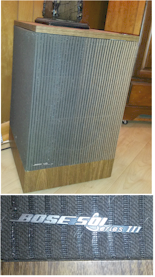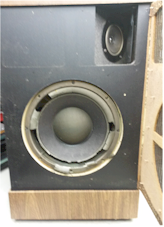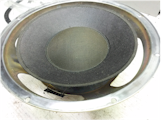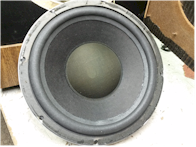Bose 501 Series III Speakers : Woofer Foam Repair Kit by Speaker World Online

Bose sold these floor standing systems in the early 1980s which is when I bought my set new. They look great, are substantial units and I have had years of good listening with them.
After 35+ years, the woofer foam that mounts to the cone and the metal frame had deteriorated to the point where a repair was needed. When this has had happened with other speakers, I usually just bought replacements and moved on.
But with these Bose woofers, I was impressed at the magnet size, the design of the cone and the overall quality of the materials so I decided to refoam them myself with a kit from Speaker World online.com .
[Note: Speaker World online.com are not sponsors of this post. I paid full price for this kit and this is an independent review]
I knew before I bought the kit that this was going to be a lot of work so let’s get started and I will share my experience.
As is well documented on the internet, the first challenge is removing the speaker grill. Bose chose to staple a 3-sided grill that wraps around the front and two sides. The only way is to start on the back edge with a wide bladed long handle screwdriver and a flash lite. Slowly work your way lifting the board while looking between the cabinet and the now slowly separating grill for staples. Get the screwdriver as close as you can to the staple. This takes time.

Once you have a side and front removed it is time for inspection. You can see just how bad the foam was in the "before" picture.
The Speaker World kit comes with very detailed instructions and photos. There are excellent tips they provide on how to inspect a woofer to determine if it is even worth repairing. My set passed this precheck so on to the hard part. Be sure to record the positive and negative wire connections to the woofer!
Removal of the old deteriorated foam from the cone and frame was easy as it just fell off. The hard part is dealing with the glue. And it is critical to get that woofer frame down to bare metal to give the glue maximum chance of bonding. Again, the instructions give lots of suggestions and are clear that if one technique doesn’t work, then try another.
For me, I used a razor knife to clean the residue from the cone and it wasn’t difficult. The metal frame was more work.

First, I used the same razor knife blade to get most of it from the metal frame on a first pass. Then out came a Dremel with a soft green grinding stone. Then, a final pass with an abrasive polishing wheel. I had to experiment to find a stone that would work and also had to clean it frequently with a quick touch on emery cloth as the residue would clog the stone. Finally it was done and it had the mirror like surface I wanted.
I couldn’t see any way to clear the residue from the outer gasket, so decided I would do my best with the razor knife and just flip it over to use the clean side for glue. While this means the outer gasket with old glue is on the outside, it will be hidden behind the speaker grill.
The Speaker World foam kit really impressed me with quality material and a laser-perfect fit. I even pulled my Jewelers loupe and couldn’t see any defects or bubbles in that foam.
The instructions provide several suggestions as to how to proceed with the glue steps. I chose to attach the foam to the cone and let it sit over night. Then, next day I glued the foam to the frame and the outer gasket seal. I let that sit over night.
A note on the glue. It is a special formulation and the nozzle size was perfect and I had no trouble getting a bead I liked. But, I had trouble at the end getting the glue out as I found the container really hard to squeeze. I had enough glue but if I had to get the last bit out I would have had to cut the case or something.

Reassembly of the grill on the Bose 501 Series III is tricky too. First, make sure you spread out the staple points as much as you can and get them straight. I debated pushing them back out so the board could mount flat but it looked like that would be risky in terms of damaging the grill. So, I kind of went with coaching them back in with a hammer and if they didn’t I pulled them out. I used some small black carpet nails to replace the few staples that wouldn’t go back in.
So, how do they sound? Of course they sound better because now the woofer can move air as the foam is complete and airtight! I imagine that the factory foam deteriorated over many years and I can’t recall enough about the original factory sound from 30 years ago to comment. I will say that the speakers sound “tighter” and I have to crank up the volume a bit more on my set but this is not a concern. Let hope they last another 35+ years !
Summary : If you have or come accross a vintage set of speakers like these Bose and you have a shop and tools to do this type of repair by all means consider the kits from Speaker World online.
[Note: Speaker World online.com are not sponsors of this post. I paid full price for this kit and this is an independent review]